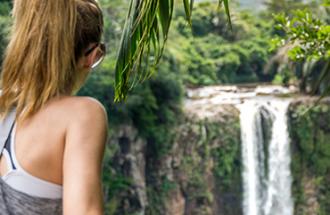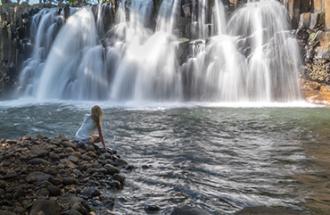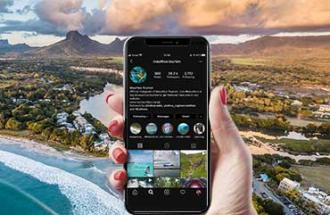Where to Stay
Where to Stay
The North
Dubbed the Creole Cote D’Azur, and with more sandy beaches and sunshine than anywhere else on the island, the north is understandably popular. Grand Baie is the centre of the action, situated on a horseshoe-shaped sheltered bay around an emerald lagoon on the northwest coast. It has hotels aplenty, shopping and the island’s best nightlife – around 50 restaurants line the coastal road to Pereybère.
The starting point of nautical trips to the northern islands and other sea activities, the north of the island also has plenty of beaches, each one more beautiful than the next. The most popular ones among Mauritians and tourists are Trou aux Biches, shaded by casuarinas, and the long curvy beach of Mont Choisy which continues from Pointe aux Canonniers to Grand Baie and to the divine Pereybere public beach. Cap Malheureux is an incredibly picturesque village – famous for its red-roofed church, view of the northern islands and its important fishing community.
The East
The breezy east coast is the Mauritius of the posters and undoubtedly one of the island’s most beautiful coastlines set alongside emerald coloured lagoons. Punctuated with numerous luxurious hotels and authentic villages, the several kilometres long Belle Mare beach is its main attraction.
Ile aux Cerfs - a water sports paradise - is a must-see. Complete with a lively boat-house, long beaches as well as a tortoise farm, this unique island can be reached by speedboat, pirogue, glass bottom boat, catamaran or even by pirate ship.
The public beach of Roches Noires extends to Poste Lafayette, an excellent place for fishing and breathing in the crisp air. Bras d’Eau is a small bay inside the lagoon of Poste Lafayette. Its public beach has a view of the south, which means that you can see both the sunrise and the sunset - unique in the East. At night, it is the best place in Mauritius to see the Milky Way.
The East Road is far less travelled than those of the West and the North, but is well worth the detour. It snakes down from Grand River South East to Mahebourg along the coast, taking you through small agricultural and fishing villages, with stunning views of the Grand Port mountain range and the turquoise lagoon that stretches from Trou d’Eau Douce to Blue Bay.
The South
The wildest and most beautiful landscapes of the island are in the South: sandy beaches bordered by cliffs carved by waves, rocky shores, sugar cane fields as far as the eye can see, and mountainous terrains offering magnificent panoramas. The rustic coastal road winds past the surf-sculpted basalt cliffs at Gris Gris to the rocky monolith of Le Morne Brabant, taking in fishing villages, roadside fruit stalls and deserted beaches. Glass-bottom boat trips head out from Blue Bay Marine Park in the southeast .Encounters with crocodiles, giant tortoises and the Mauritius fruit bat or iguana await you at La Vanille Nature Park. One of the main fishing villages on the island, Mahebourg is built along the shore of the immense bay of Grand Port.
The beaches in this part of Mauritius are rare but striking. One of them is the famous family Blue Bay beach which is surrounded by a semicircle of casuarinas and considered one of the nicest of the island with its fine sand, clear water and lively corals, perfect for snorkelling.
The Baie du Cap road is considered to be among the best roads to drive in the world and the famous hairpin bend is where many tourists stop and take photos from the rocky outcrop which offers a stunning view of the sea below and the beautiful southern coastline.
The West
The sheltered west coast has calm, shallow golden-sand beaches favoured by young families, particularly around the resort areas of Flic en Flac and the quieter Wolmar. Protected from the prevailing winds, the region boasts some superb hotels and lagoons calm enough for swimming, snorkelling, diving, water-skiing, kayaking, pedal boats and sailing activities.
Head to Tamarin Bay, or to the world famous “One Eye” at Le Morne, where you can find the best waves for surfing. Le Morne is also well known by kitesurfers due to the steady winds that blow in from the South-East and accelerate in this corner of the island almost all year round. Tamarin Bay is however best known for dolphin-swimming, while Black River (Rivière Noire) is famous for big game fishing.
Eco-adventure park Casela offers encounters with African animals and activities galore, from mud-karting to a canyon swing. For nature lovers, the verdant Black River Gorges National Park provides glimpses of rare birds including the echo parakeet. Flanked by statues of Hindu gods, Grand Bassin, also known as Ganga Talao is a crater lake surrounded by temples most vibrant during festivals; while the Chamarel highlands have the geological marvel of the Coloured Earths and the new Ebony Forest Reserve.
Central
Cooler than the coastal regions, the central plateau is situated between 400 and 600 meters above sea level. Starting from the South of Port Louis, this vast urban area is home to about 400,000 people, representing over one-third of the island's population. High up on the plateau, you’ll also find forests, lakes and plantations that are well worth a visit.
Four towns, namely Rose Hill, Quatre Bornes, Vacoas and Curepipe, make up the heart of the island.
Rose Hill’s busy high street is swarming with shoppers during the day and is worth a visit if you’re ready to brave the crowds and look for some great bargains. There are many shops to browse around and local restaurants to choose from.
Quatre Bornes is a cosmopolitan town, where you will be able to bargain for great deals at its famous market. The shops on the main road are also a good place for discount hunting!
The town of Vacoas is best known for the Gymkhana Golf Club, the oldest golf course in the southern hemisphere. Locals run and walk around the outdoor track for exercise and play football in the grounds.
Finally, Curepipe, where you’ll experience the coolest temperatures in Mauritius, has retained its charm and is home to two of the island’s treasures: Trou aux Cerfs, the crater of a dormant volcano, and the Botanical Garden with its rare plant species.




